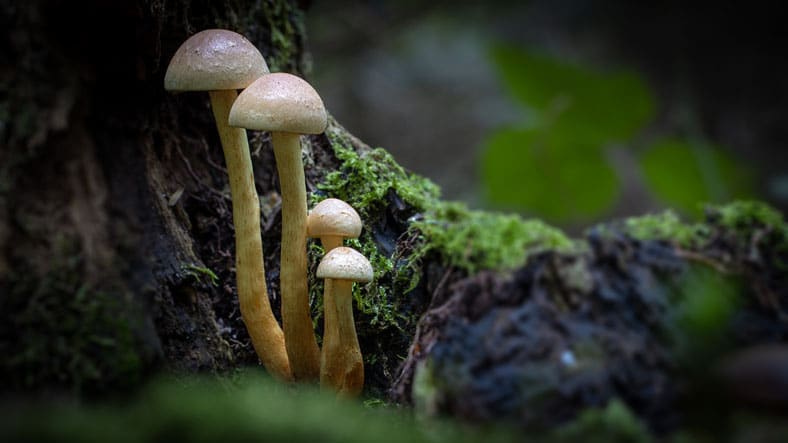 Michael Weidemann / 500px/Getty Images
Michael Weidemann / 500px/Getty Images When we venture out onto a hiking trail through a forest or sit in the shade underneath a healthy canopy of leaves rustling peacefully in the wind, it is easy to forget that the unforgiving rules of nature—survival and competition—are in full effect. In a way, every forest experiences a constant but silent war where a tree’s life is determined by its access to water, nutrients, and sunlight.
However, a new Israeli study reveals that in the soil there is a whole system of remedies occurring between the trees themselves in which weak ones receive help via their roots from the stronger, more dominant trees; all under the auspices of a network of mutualistic fungi. Otherwise, it is difficult to imagine what exactly a robust tree is to gain by donating its own resources to competitor trees.
Carbon is Currency
To understand how fungi form connections between different trees and why they have a biological interest in doing so, the relationship between fungi and a single tree must first be understood.
“Trees are naturally in symbiosis with a group of fungi known as mycorrhiza,” explains Dr. Stav Livne-Luzon, researcher from Dr. Tamir Klein’s tree laboratory at the Weizmann Institute.
“The fungus needs the roots of the trees to live, because the tree is its main supplier of carbon, and carbon is the tradable currency in a forest. The trees fix it from the atmosphere as part of the photosynthesis process, then they pass it to living organisms through the roots. In return, the fungus provides the tree with essential nutrients and minerals such as nitrogen and phosphorus, which the tree does not know how to produce on its own,” she explains.
In fact, according to a previous study Dr. Livne-Luzon conducted, Jerusalem pine trees in particular are unable to grow taller than a few inches without the presence and cooperation of the mycorrhiza.
You Get Some Carbon, and You Get Some Carbon!
Soon to be published in The ISME Journal and led by Dr. Livne-Luzon and Rotem Cahanovitc, the first phase of the study examined the role of fungi in sharing carbon between trees. Although earlier studies have found that carbon can be absorbed from the atmosphere by one tree and move to a nearby tree through the ground, the exact way it happens had not been demonstrated.
With the support of the EU Research Council and the Jewish National Fund (JNF), who donated Jerusalem pine (Pinus halepensis) and common oak (Quercus robur) seedlings for the study (the two most common types of trees in Israel’s forests), the researchers built multiple experiments using three tree seedlings—one central tree with two adjacent trees planted on either side.
Between the first tree and one of the adjacent ones, the researchers placed a net that restricted contact between the roots, but allowed a mushroom net to connect them. The other adjacent tree, however, was completely separated from the other two by an underground partition.
The researchers then built a transparent box around the central tree, into which they pumped carbon dioxide gas, but they used carbon-13 (¹³C) for the experiment even though carbon-12 (¹²C) is more naturally abundant. Both have very similar properties, but they used ¹³C because it is more easily detectable.
“We found the presence of the ¹³C in the neighboring tree that was attached via the mycorrhiza,” says Dr. Livne-Luzon. The amount of carbon that the oaks transferred to each other was similar to that which the pines transferred to each other, and the carbon transferred from pine to oak and vice versa yielded similar results as well.
“However, our main discovery is that we have identified which species of mycorrhizae transfer carbon between trees and increase connectivity in the soil and which species do not.”
“Robin Hood” of the Forest
Using the same three-tree configuration, the researchers continued the next stage of experimentation but this time placed a covering over the adjacent trees to restrict their accessibility to light while leaving the central tree undisturbed.
“We could see that the carbon passed from the healthy central tree, which was exposed to light and thus capable of performing photosynthesis, to the connected lateral tree, which was starving and unable to fix carbon for itself,” Dr. Livne-Luzon explains.
According to the researchers, this sacrifice or transference of resources is not due to the stronger tree’s generosity, but rather the result of the fungi that connects the trees.
“Trees have no reason to cooperate because it does not benefit them,” says Dr. Livne-Luzon. “The fungi, however, act as the Robin Hood of the forest. They take any resources that a healthy tree is able to spare and pass it on to a nearby suffering tree. In doing so, the fungi invest in the forest’s future to account for any unpredictable disturbances that may cause a tree to fall or die—lightning strikes, for example.”
Researchers have also hypothesized that the transfer of carbon may be a byproduct of the amino acids transfer (which also contain carbon) from the fungus to the trees.
Regardless, the study indicates that fungal-mediated intertree collaboration is beneficial for all trees even when solar distress is not present. In the last phase of the experiment, in which about 80 additional triplets of trees were examined, the researchers concluded that trees connected to each other by a network of mycorrhizae fungi thrive far better than trees without them.
Despite this discovery, it will not be necessary for JNF foresters to manually plant spores of the appropriate fungi amongst the roots of trees.
“These mushrooms are common on their own and know how to take care of themselves,” says Dr. Livne-Luzon, who notes that natural forest soil was used in the experiment.
“What can be taken from the study is the understanding that underground connectivity is a delicate social game, one that if we disrupt even slightly could jeopardize the plants’ survivability.”
“It is important to understand which fungi increase connectivity in the forest and to investigate how rising global temperatures and direct human actions such as fires, thinning, or the planting of other species affect them,” she concludes.
ZAVIT – Science and the Environment News Agency























 More news and opinions than at a Shabbat dinner, right in your inbox.
More news and opinions than at a Shabbat dinner, right in your inbox.